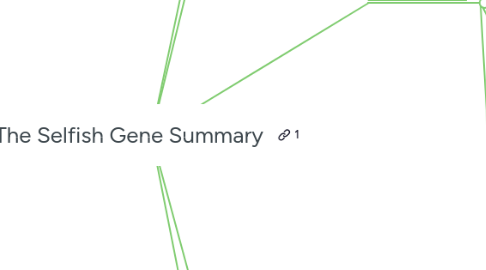
1. 1-Sentence-Summary:
1.1. The Selfish Gene explains the process of evolution in biology using genes as its basic unit, showing how they manifest in the form of organisms, what they do to ensure their own survival, how they program our brains, which strategies have worked best throughout history and what makes humans so special in this context.
2. Favorite quote from the author:
2.1. "Let us understand what our own selfish genes are up to, because we may then at least have the chance to upset their designs, something that no other species has ever aspired to do." - Richard Dawkins
3. 3 lessons:
3.1. Even though mutually altruistic behavior is atypical, it can sometimes benefit the genes of two different organisms.
3.1.1. Because genes are selfish, a lot of the relationships among organisms in nature end up being so-called zero-sum games: there’s always one clear winner and one clear loser.
3.1.1.1. When a hawk chases a dove, either the dove ends up getting eaten or the hawk starves.
3.1.2. In a non-zero-sum game though, both parties can team up against a third party (which can be nature itself, for example) to create a win-win situation.
3.1.2.1. For example, if you and your friend are clients at the same bank, and the bank makes an individual offer to both of you for a great set of stock tips, but wants to charge $5,000, then just one of you could take the offer and you split the cost, instead of paying $5,000 each for the same set of tips.
3.1.3. Sometimes this kind of thinking pays off in nature too.
3.1.3.1. For example, ants “milk” little insects called aphids, because the sweet secretions they produce are nourishing.
3.1.3.2. In exchange, aphids benefit from having strong fighters like the ants around to protect them. The ants even take baby aphids in custody inside their ant hills to raise and protect them from predators.
3.1.4. While the selfish motives of the genes of each species stay the same, mutual altruism leads to the best result.
3.2. We’ve spliced off the element of culture and given it its own evolutionary cycle.
3.2.1. Humans are special. We’ve evolved far beyond the instinctive survival-thinking our genes originally drove us towards.
3.2.1.1. For example, something as complex and various as human culture (which includes things like language, religion, fashion, art, customs, diet, etc.) can’t possibly be the result of genes striving for survival.
3.2.2. Culture can be seen as a spin-off, separate from biology, created by humans, that relies on the same evolutionary principles.
3.2.3. Just like the gene is the basic element of biological evolution, a meme is the basic element of culture.
3.2.4. Since genes can be copied across organisms, they’re near-immortal, and memes are the same – the smallest unit of culture that has a chance of being immortal
3.2.4.1. For example a certain melody, a powerful idea, or a video.
3.2.5. Memes also compete, in their case for human attention and memory. If a meme is forgotten, it dies, so like genes, memes cooperate to form complex entities, similar to organisms.
3.2.5.1. For example, the Catholic Church is a huge set of memes, such as certain ideas, rituals, behaviors, clothes and architectural styles, all centered around the meme of God.
3.2.6. This explains how ideas like celibacy, the practice of abstaining from marriage and sex, can survive.
3.2.6.1. It’s counter-intuitive to the selfishness of genes, but as long as the idea survives in the evolutionary system of culture by being part of an entity like church, this meme is considered a success.
3.3. Humanity can overcome the downsides of selfish genes thanks to simulation and foresight.
3.3.1. While mutual altruism can sometimes have short-term benefits for the lifespan of individual organisms, it’s usually still based on selfish intentions.
3.3.1.1. In a few cases though, an even better solution would be to abandon our immediate survival interests altogether and cooperate for the long term.
3.3.2. For example, in the hawks vs. doves example, where doves always try to flee and hawks always attack until they win or are seriously injured, something called a “conspiracy of doves” could increase survival for both species in the long run.
3.3.2.1. If all animals in the population “agreed” to act like doves, then they could live in peace and without harm alongside each other.
3.3.2.2. Hawks would just eat the doves that are sick or about to die and avoid injury, doves wouldn’t have to worry about being hunted down all the time – and both could reproduce.
3.3.3. Genes aren’t conscious, they can’t foresee and simulate the future like we can, so they can never choose a “conspiracy of doves” scenario. But we can.
3.3.3.1. By abandoning our selfish motives and splicing off from biology, like we have done with culture, will allow us to do what’s best for the survival of the human species in the long run.
